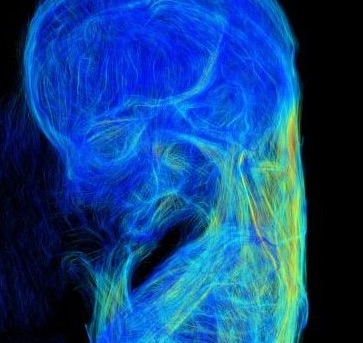石田さんの修士論文の一部がJ Anatomyに受諾されました
CS16からCS23までの合計47個のヒト胚の高解像度の磁気共鳴画像取得し、中腸のヘルニア期に中腸と腸間膜で時間の経過とともに生じる形態学的変化を検討、二次ループと三次ループの初期形成、それに続く追加ループの形成を正確に記載しました。この研究の知見は、ループ形成における遺伝的要因と生体力学的要因の役割を包括的に理解する上で極めて重要です。
71. Ishida N, Ueda Y, Kanahashi T, Matsubayashi J, Imai H, Yamada S, Takakuwa T.Hierarchical loop formation in human midgut during physiological umbilical herniation, J Anatomy 2024, in press DOI:10.1111/joa.14228

- CS16からCS18までのすべての標本で一次ループの形成が観察された。
- 腸間膜狭窄により中腸がを 4 つのセグメントに分割可能。
- 中腸の二次ループは、最初にCS19のセグメント2と4(S2とS4)で識別。
- 三次ループの形成は、CS21 で最初に確認
- CS23 までに、三次ループはほとんどの標本のS2,3,4のセグメントで観察
- S1は1つの二次ループのまま。
- 三次ループの数は頭殿長に応じて増加し、中腸の S2 から S4 で最大 19 個
- ループ形成における遺伝的要因と生体力学的要因の役割を包括的に理解する上で極めて重要
Abstract
The primary loop, a single hairpin-shaped loop, becomes recognizable at the Carnegie stage (CS) 16. This loop projects toward the umbilical cord and subsequently gives rise to four secondary loops in the midgut of human embryos. As development advances, the segments corresponding to each secondary loop further develop into an increasing number of loops, referred to as tertiary loops. The mesenteric leaves and the narrowing parts, which serve as the borders of the secondary loops, remain identifiable throughout the subsequent stages of development. This study aimed to describe the morphological alterations that occur in the midgut and mesentery over time during the herniated phase of the midgut. A total of 47 human embryos between CS16 and CS23 and two fetuses in the physiological umbilical herniated stage were selected for high-resolution magnetic resonance imaging acquisition. Specimens were obtained from the Congenital Anomaly Research Center of Kyoto University. Serial tissue sections obtained from four embryos were subjected to histological observation. The midgut and mesentery were reconstructed in three dimensions, and the resulting morphological changes were observed and analyzed. Formation of the primary loop was observed in all specimens between CS16 and CS18. Secondary loops in the midgut were initially discerned at CS19 in segments 2 and 4 (S2 and S4). The border between S3 and S4 was identified at the apex of the midgut hernia, where traces of the vitelline artery and duct enter the mesentery. At CS21 and later stages of development, the presence of three borders at the exact location delineated by mesenteric narrowing was consistently observed, which resulted in the midgut being divided into four segments in all specimens. The formation of tertiary loops was initially identified at Carnegie stage (CS) 21, occurring in either segment S2 or S3. By CS23, tertiary loops were observed in three segments in most specimens. Notably, the initial formation of tertiary loops in S4 occurred one Carnegie stage later than in S2 or S3. Additionally, the increase in the number of folds and the length per fold in S4 was delayed compared with the number and length of folds observed in both S2 and S3. The number of loops in S1 remained constant (one secondary loop) across all specimens. Upon reaching a critical threshold length, the number of loops exhibited a marked increase, accompanied by rapid elongation in S2, S3, and S4. The number of tertiary loops increased in accordance with the crown-rump length, which exhibited a maximum of 19 tertiary loops in S2 to S4 of the midgut. These findings support the hypothesis that tertiary loops develop biomechanically through the rapid elongation of the midgut and slow growth of the mesentery. This study describes the morphological alterations occurring in the midgut and mesentery over time during the herniated phase of the midgut and provides a comprehensive understanding of the roles of genetic and biomechanical factors in loop formation.







